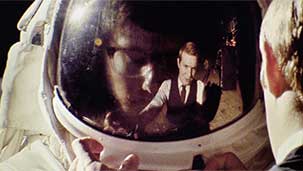Emotion is what fuels moving pictures, but trickery is the science that lifts them into orbit. Failure to launch the audience’s imagination is tantamount to a disaster. But if you can hide the blueprint, a movie can go from manufactured to magical.
The techniques used to accomplish such magic have evolved, but in the era in which Operation Avalanche is set (1967), front screen projection was the leading edge of filmmaking technology. Stanley Kubrick was perfecting it on the set of 2001: A Space Odyssey during the famous Dawn of Man sequence, using mathematical precision to remove shadows and seams that would break the illusion of never-ending depth behind the actors. And it’s in discovering this breakthrough that the characters of Operation Avalanche decide they can help NASA fake the moon landing and avoid the national embarrassment of losing the space race to the Russians.
If only it was so easy for a crew of knuckleheads to pull something like that off 50 years later.
Now, let’s be fair. In the context of a mockumentary, the expectations for making effects convincing is just a shade above “good enough.” And to that extent, this low-budget Canadian film really manages to take off (eh!). Special effects were never going to be mission critical, and the blending of grainy film footage from the era with the shaky-cam verité works—for the most part. In the press leading up to the film, Johnson and his team also made much of the fact they secretly filmed a fictional film at official NASA locations by pretending it was a documentary, but the payoff for all that undercover infiltration certainly isn’t obvious (I was far more distracted when they Forrest-Gumped themselves into mission control).
But again, your effects are not the problem. In fact, it seems as though the filmmakers took your responsibilities rather seriously, assuming that the special effects would be crucial to the effect of the movie. What they overlooked (much like the failed Apollo missions) were the small details that seemed like inevitabilities—in this case, casting. It occurred to me about two-thirds into the film that (director/co-writer/star) Matt Johnson was responsible for about 90% of the dialogue. Taking up that much oxygen in any film is dangerous, but especially one that’s as high-concept as this one, and therefore so open to other characters and plot points. Co-star Owen Williams seemed to be doing your job—trying not to cast a shadow or break the illusion by moving too far in any direction. Compared to Johnson’s manic energy, Williams is less as a straight man than a prop for Johnson to dance around.
Yet, somehow, the film works. Johnson and his team land the film without ever crossing too far into flat-out parody. Operation Avalanche is a conspiracy film for space nuts that manages some laughs while staying grounded. It’s not an easy trick to pull off, which makes the stumbling more forgivable.
Sincerely,

Christopher






